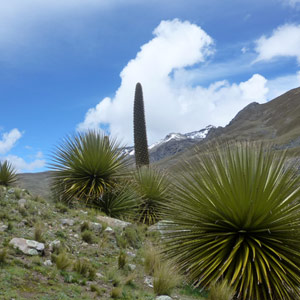Magazine | Études
Le nectar des puyas, source de nourriture pour les colibris d’altitude au Pérou

Puya raimondii, province de Huaraz (Pérou).Photographie : Vane59 / Wikimedia Commons
Introduction
Dans la majorité des biotopes tropicaux, les oiseaux jouent un rôle important dans la pollinisation, agissant comme des disséminateurs des graines ou du pollen. De nombreuses recherches sur la pollinisation par les oiseaux ont été menées dans les forêts d’Amérique tropicale, mais de nombreuses questions demeurent sur ce phénomène en haute altitude.
Ainsi, au-dessus de 3000 mètres, dans les secteurs rocheux et les prairies proches du département péruvien d’Ancash, Letty Salinas, César Arana et Mery Suni ont noté une pauvreté relative en plantes ornithophiles (= qui utilisent les oiseaux pour leur pollinisation). Néanmoins, les trois chercheurs ont découvert de petits peuplements de Puyas (Puya sp.), de grandes plantes ornithophiles qui constituent conséquence une importante ressource alimentaire pour les colibris d’altitude.
Cette étude a été publiée en août 2007 dans la Revista Peruviana Biologica (14(1): 129- 134).
Abstract
In the high Andean region of Ancash (Peru), the greatest diversity of flowers ornithophilous is in shrublands, in contrast to rocky areas and grasslands, in those that we find stands of bromelias of the genera Puya whose nectar could constitute an important resource for high Andean hummingbirds in these habitat types. To document this hypothesis, during 2004-2005, in 264 hours of observation, were evaluated the hummingbirds of two stands of Puya above the 3000 m of altitude.
The first stand was of Puya raimondii in a grassland of the Huascarán National Park (9º39′ S-77º13′ W), the second was of Puya rauhii in rocky areas of the Conchucos Valley (8º10′ S-77º52′ W). The frequency of visit of hummingbirds to the inflorescences of Puya was evaluated from 10 fixed points of observation, also captures with mist nets allowed to identify the pollen of their bill and front.
In P. raimondii four species of Trochilidae were identified feeding of their nectar (Oreotrochilus stolzmanni, Patagonia gigas, Aglaeactis cupripennis and Metallura phoebe), being O. stolzmanni the frequently sighted species (60%). 80% of the obtained samples of pollen of these hummingbirds corresponded P. raimondii.
In the rodal of Puya rauhii was identified ten species of Trochilidae (Colibri coruscans, Oreotrochilus stolzmanni, Patagonia gigas, Aglaeactis cupripennis, Coeligena iris, Chalcostigma stanleyi, Lesbia nuna, Myrtis fanny, Metallura phoebe and M. tyrianthina), being the species with more sightings M. phoebe (26%), C. coruscans (21%) and P. gigas (17%). 31% of the obtained samples of pollen of these hummingbirds corresponded to Puya. The high Andean species of Puya provide an important nutritious resource for hummingbirds, especially for those of high altitudes where the diversity of plants diminishes.
This study has been published in August 2007 in the Revista Peruviana Biologica (14(1): 129- 134).
Poursuivez la lecture de cet article, en vous abonnant dès maintenant !
Découvrez les Archives d’Ornithomedia.com
Pour seulement 10,00 €TTC/an (ou 6,00 € les 6 mois)
Profitez de plusieurs centaines d’articles en accès illimité et sans aucun engagement.
Compléments
À lire aussi sur Ornithomedia.com
Ouvrages recommandés
- The Complete Book of Hummingbirds de Tony Tilford
- Birds of Peru de Thomas S. Schulenberg, Douglas F. Stotz, Daniel F. Lane et John P. O’Neil




 2 commentaires
2 commentaires
2 commentaire(s) sur ce sujet
Participer à la discussion !Marie Chaulet
St Barthélémy
Posté le 31 mars 2016
je souhaiterai acheter de la nourriture pour Colibri Merci de me diriger ver un site
David Bismuth
sevran
Posté le 01 avril 2016
bonjour, en fait le plus simple est de leur donner de l’eau sucrée (sucre de canne ou de betterave) et de planter des fleurs qui leur fourniront du nectar. Nous avons publié un article sur le sujet : http://www.ornithomedia.com/pratique/conseils/attirer-nourrir-colibris-souimangas-dans-jardins-01359.html